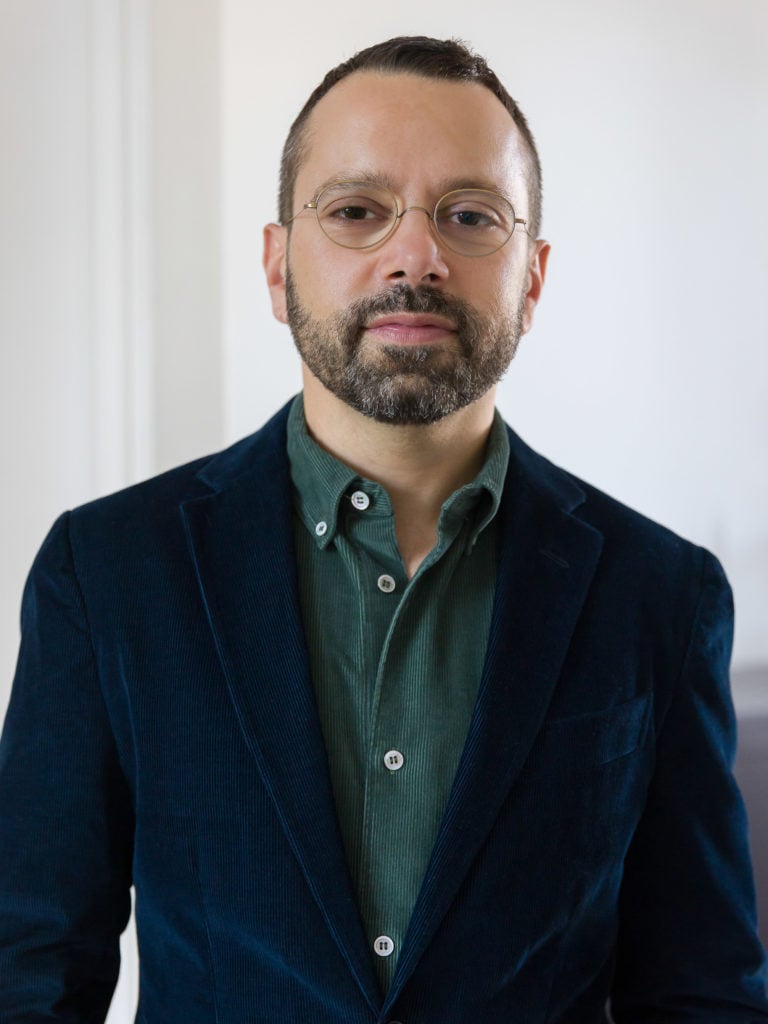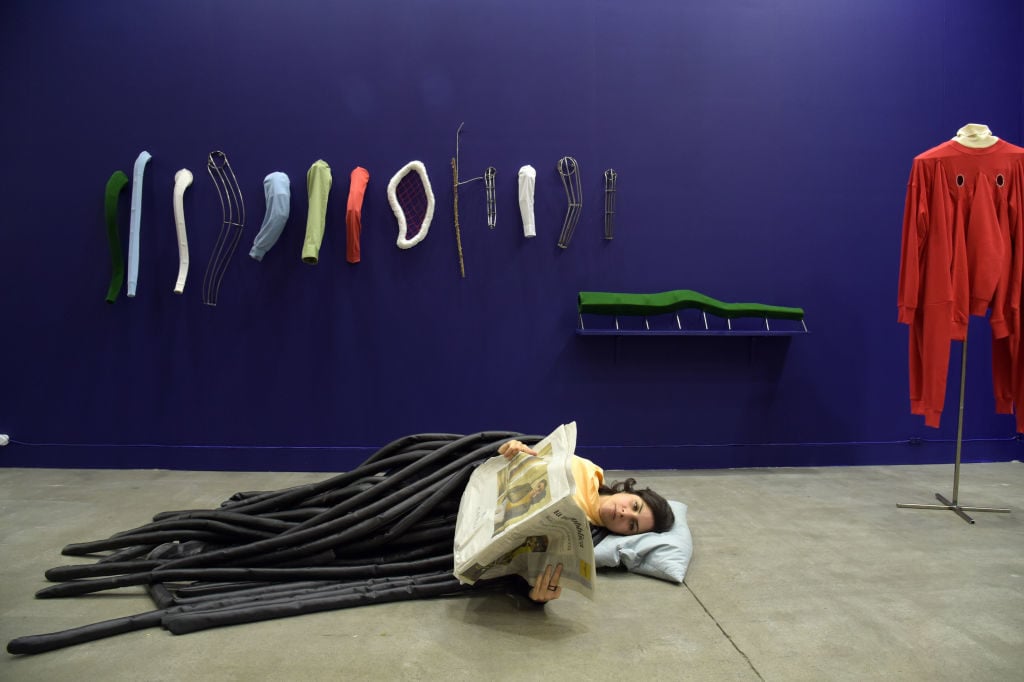Art Fairs
‘A Fair Is a Meeting Place’: Miart’s Director on Why Blue-Chip Dealers Are Flocking to the Italian Art Fair
Hauser & Wirth and Marian Goodman are among the galleries flying to Milan this week.

Hauser & Wirth and Marian Goodman are among the galleries flying to Milan this week.

Naomi Rea

The Milan International Fair of Modern and Contemporary Art, or miart, opens its 24th edition to the public on April 5 (through April 7).
In 2019, the fair could play an important role in bringing together the international art community against the troubling backdrop of rising nationalist politics in Italy, where the populist government has favored an “Italians First” policy for museum directors. In that environment, miart’s artistic director, Alessandro Rabottini, recognizes the lasting importance of welcoming a multitude of voices to the fair. We spoke with Rabottini about his vision for the exhibition, the habits of Italian collectors, and the importance of the little-guy gallery to the art system.

An artwork by Eva Kot’atkova is displayed at the Miart 2018 opening. Photo by Pier Marco Tacca/Getty Images.
This is the third edition of miart under your leadership as artistic director. What were the main changes that you brought to the fair, and how do you see it evolving under your care?
Having worked for miart in the former role of deputy director in 2016 before starting to serve as artistic director in 2017, I inherited a format that I helped to develop. In this sense, I wanted to further explore a conceptual and spatial architecture that was already there and that I think still has a lot to say, especially when it comes to creating of dialogue between contemporary positions and modern masters, which is most probably our main narrative.
I think that both galleries and collectors need a space they feel comfortable with, and to create that space takes time. From a curatorial point of view, you can come up with new sections and ideas, but ultimately I think my job is to listen and try to shape an environment for the artworks to be the protagonists. That said, I am extremely proud of how deep the relationship between miart and the entire city has become in these three years, and I believe that it is precisely this bond that has been attracting a more and more international audience.
Against the backdrop of rising nationalist politics in Italy, which has even threatened the positions of some international museum directors, what role do you see an international art fair as playing?
A fair is, by definition, a meeting place. People from different countries meet in a specific location and, in a very short span of time, exchange a large amount of information about artworks and artists reflecting an incredibly diverse range of cultures, practices, and media.
At its best, a fair is a feast of artistic inputs, in which chronology and nationality are set into dynamic motion, and it is vital for a fair to serve as platform for a polyphony of voices. Every time I visit a fair, I learn about artists and galleries that I didn’t know before, and that is something that we shouldn’t take for granted. Even when walking through a fair can turn into a tiring experience, fairs are still chances to expand our understanding of how diverse cultural practices can be. The more tools we have to understand each other, the closer we become.
Miart has always had a strong showing of local galleries. Is that is important to Italian collectors? Do they take an “Italians first” approach to buying art?
Italian collectors are extremely well informed, they are very curious and they travel a lot. If you look at many Italian collections, you’ll see that a lot of international artists have been supported by Italian collectors way before they became fashionable on the international scene.
miart features many Italian galleries for a number of different reasons. First of all, Italy is different from other countries: good galleries with an international program, in fact, are not concentrated in one or two big cities, but you find them in Milan, Rome, Turin, Naples, Florence, Bologna and even in smaller towns. And this true also for collectors. miart reflects the diversity of Italy’s galleries landscape.
There are a number of high-profile international galleries signing on to the fair this year for the first time, including Hauser & Wirth, Marian Goodman Gallery, and Galerie Thaddeus Ropac. Why do you think they are being drawn to the historically local fair at this time?
This a process that began years ago. Galleries of primary importance such as Massimo De Carlo, Gladstone Gallery, Galerie Lelong—only to name a few within the field of contemporary art—have been participating in miart for years now. They created the context for a fair that collectors take seriously.
We should also consider that many Italian collectors have an historical understanding of art: they look at contemporary art with a profound knowledge of art from the past, and this creates an environment for a different kind of conversation, a type of dialogue that many international galleries enjoy to have.
The annual art fair calendar is putting pressure on many smaller and mid-sized galleries, which struggle to keep up with the costs. Like many fairs, miart offers lower-cost booths to emerging galleries to help them participate in the fair. How important is it to the fair’s ecosystem that these galleries continue to participate? What would happen if they began to pull out?
The participation of emerging and mid-sized galleries is fundamental. These are the galleries that support young artists at the beginning of their careers, that explore experimental practices and that push the boundaries of what can be understood as collectable.
More recently, smaller galleries have also been among the first ones to show artists from previous generations that have been overlooked due to gender or cultural gaps. Either as a collector or a museum curator, a writer or a fair organizer, we are all in debt to the risks they take, and it’s a collective responsibility to create a sustainable environment for them.
Finally, Milan has become a hub for private foundations, many of which are pulling out the stops for Milan’s art week. How does the fair fit into the city outside of the walls of the pavilion?
Fiera Milano—the company that organizes miart—is lucky enough to partner every year with the Municipality of Milan and to promote the Milan Art Week. If miart has become more and more attractive for international audiences, this is largely because Milan, in recent years, dramatically changed and became a unique ecosystem for public institutions and private foundations. For miart, this context is of vital importance. Being in the position to welcome our visitors and having newly commissioned exhibitions promoted on the occasion of the fair by key players such as Pirelli HangarBicocca, Fondazione Prada, Fondazione Trussardi, and Palazzo Reale, only to name a few, gives us the opportunity to contextualize what we do as a fair in a much broader cultural scenario.
I couldn’t be more grateful to all of them for putting up such an extensive number of exhibitions, which this year includes newly commissioned shows by Lizzie Fitch [and] Ryan Trecartin, Ibrahim Mahama, Sheela Gowda, Giorgio Andreotta Calò, Carlos Amorales, Anj Smith, and Sophia Al-Maria, together with a timely homage to Hans Josephsohn. Extensive retrospective exhibitions will be dedicated to women artists whose fundamental contributions evolved outside of canonical movements, and I am thinking of Anna Maria Maiolino, Lygia Pape, Marinella Pirelli, and Renata Boero.
Two large group exhibitions—”The Unexpected Subject: 1978 Art and Feminism in Italy” and “Broken Nature: Design Takes on Human Survival”—will explore some of the most urgent issues of our times, while a selection of video works from the Wemhöner Collection will be staged under the frescos of Tiepolo at Palazzo Dugnani.